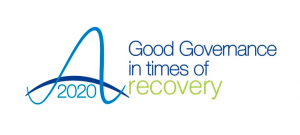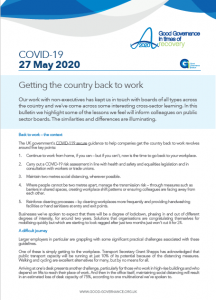Getting the country back to work
27 May 2020

Our work with non-executives has kept us in touch with boards of all types across the country and we’ve come across some interesting cross-sector learning. In this bulletin we highlight some of the lessons we feel will inform colleagues on public sector boards. The similarities and differences are illuminating.
Back to work – the context
The UK government’s COVID-19 secure guidance to help companies get the country back to work revolves around five key points:
1. Continue to work from home, if you can – but if you can’t, now is the time to go back to your workplace.
2. Carry out a COVID-19 risk assessment in line with health and safety and equalities legislation and in consultation with workers or trade unions.
3. Maintain two metres social distancing, wherever possible.
4. Where people cannot be two metres apart, manage the transmission risk – through measures such as barriers in shared spaces, creating workplace shift patterns or ensuring colleagues are facing away from each other.
5. Reinforce cleaning processes – by cleaning workplaces more frequently and providing handwashing facilities or hand sanitisers at entry and exit points.
Businesses we’ve spoken to expect that there will be a degree of lockdown, phasing in and out of different degrees of intensity, for around two years. Solutions that organisations are congratulating themselves for mobilising quickly but which are starting to look ragged after just two months just won’t cut it for 24.
A difficult journey
Larger employers in particular are grappling with some significant practical challenges associated with these guidelines.
One of these is simply getting to the workplace. Transport Secretary Grant Shapps has acknowledged that public transport capacity will be running at just 10% of its potential because of the distancing measures. Walking and cycling are excellent alternatives for many, but by no means for all.
Arriving at one’s desk presents another challenge, particularly for those who work in high-rise buildings and who depend on lifts to reach their place of work. And then in the office itself, maintaining social distancing will result in an estimated loss of desk capacity of 75%, according to one multinational we’ve spoken to. In its case, the task is to find ways of scaling down 60,000 seats to 15,000 and finding IT solutions for complex cyber security for home workers in the financial and insurance sectors.
So it seems likely that there will be a considerable further period of homeworking for many, with all that implies – both for employers and employees. As we’ve said before, not all workers come to home working equally. If home becomes the longer-term workplace then employers need to think about everything from health and safety, mental health and well-being through to cyber security. Employers are needing to get to know their staff in ways they never imagined they would have to, or indeed considered appropriate.
Major employers tell us that this emergency distributed working model has resulted in quicker decision-making, as individuals step up and take responsibility rather than relying on approval by committees.
It’s not a straightforward picture though. One major bank said this freer flowing working model initially led to improvements in productivity as value was released quicker. But that in turn led to more projects being in progress at any given time, which meant that inefficiencies started to creep into the system, leading to a subsequent fall in productivity.
Weeding out inefficiencies
The emergency working model has also revealed inefficiencies in the way organisations worked and it’s important that these are identified and not allowed to creep back in as we continue our journey towards the new normal.
It’s not just commercial boards that have this opportunity. Committees add time to any decision-making process and, while no one would advocate dispensing with the idea of collective responsibility, it’s worth assessing whether duplication or overcomplication had crept into the old ways of doing things.
There are three lessons we have gleaned from the commercial world that all boards would do well to consider:
1. When operating a highly distributed model, having the right data and productivity information is crucial. It’s good to understand capacity information but many boards don’t have a deep enough understanding of the flow of work and productivity in their organisations.
2. When things are done at pace in this sort of distributed working model, there’s a greater likelihood – an inevitability, in fact – that mistakes will be made. Boards should consider the important cultural issue of how they respond to these mistakes.
3. Knowing your people is vital. We are all affected by COVID-19 in different ways, whether it’s a challenging living environment, dealing with the impact of bereavement, or struggling to deal with caring challenges. How well do you really know the people you work with? The pandemic presents us all with an opportunity to be more caring. We have seen improvements in the levels of empathy displayed by employers. Let’s make sure they are maintained. Last week, GGI issued a bulletin on kindness as part of mental health awareness week.
Kindness is key
As a final remark we were struck by the number of those we talked to who had surprised themselves. This crisis has pushed teams together and one non-executive summed up the sentiments of many when he said ‘We learnt we were kind. Indeed, we learnt we needed to be kind. We had to ask more of our staff than we ever expected we would have to and needed to be an employer that was genuinely concerned with the welfare in every way for our staff.’
If this briefing prompts any questions or comments, please call us on 07732 681120 or email advice@good-governance.org.uk.

Martin Thomas
Copywriter

